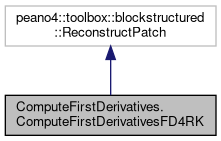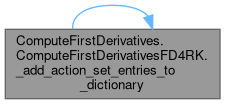|
Peano
|
|
Peano
|
Explicit reconstruction of first derivatives for FD4 discretisation. More...


Public Member Functions | |
| __init__ (self, solver, is_enclave_solver) | |
| user_should_modify_template (self) | |
| get_includes (self) | |
| get_body_of_operation (self, operation_name) | |
| get_action_set_name (self) | |
Static Public Attributes | |
| ComputeDerivativesOverCell = jinja2.Template( + ) | |
Protected Member Functions | |
| _add_action_set_entries_to_dictionary (self, d) | |
| This is our plug-in point to alter the underlying dictionary. | |
Protected Attributes | |
| _solver = solver | |
| _butcher_tableau = ButcherTableau(self._solver._rk_order) | |
| _use_enclave_solver = is_enclave_solver | |
Explicit reconstruction of first derivatives for FD4 discretisation.
FD4 is implemented as Runge-Kutta scheme. So we first have to recompute the current solution guess according to the Butcher tableau. Then we feed this reconstruction into the derivative computation. In theory, this is all simple, but in practice things require more work.
We assume that developers follow ExaHyPE's generic recommendation how to add additional traversals. Yet, this is only half of the story. If they follow the vanilla blueprint and plug into a step after the last time step
then the reconstruction is only done after the last and final Runge-Kutta step. Alternatively, users might plug into the solver after each Runge-Kutta step. In principle, we might say "so what", as all the right-hand sides after the final step are there, so we can reconstruct the final solution. However, there are two pitfalls:
Consequently, we need special treatment for the very last Runge-Kutta step:
The actual derviative calculation is "outsourced" to the routine
Wrapping up oldQWithHalo and newQ in a CellData object is a slight overkill (we could have done with only passing the two pointers, as we don't use the time step size or similar anyway), but we follow the general ExaHyPE pattern here - and in theory could rely on someone else later to deploy this to GPUs, e.g.
Right after the reconstruction, we have to project the outcome back again onto the faces. Here, we again have to take into account that we work with a Runge-Kutta scheme. The cell hosts N blocks of cell data for the N shots of Runge-Kutta. The reconstruction writes into the nth block according to the current step. Consequently, the projection also has to work with the nth block. exahype2.solvers.rkfd.actionsets.ProjectPatchOntoFaces provides all the logic for this, so we assume that users add this one to their script. As the present action set plugs into touchCellFirstTime() and the projection onto the faces plugs into touchCellLastTime(), the order is always correct no matter how you prioritise between the different action sets.
Further to the projection, we also have to roll over details. Again, exahype2.solvers.rkfd.actionsets.ProjectPatchOnto has more documentation on this.
Definition at line 10 of file ComputeFirstDerivatives.py.
| ComputeFirstDerivatives.ComputeFirstDerivativesFD4RK.__init__ | ( | self, | |
| solver, | |||
| is_enclave_solver ) |
Definition at line 99 of file ComputeFirstDerivatives.py.
References __init__().
Referenced by __init__().


|
protected |
This is our plug-in point to alter the underlying dictionary.
Definition at line 201 of file ComputeFirstDerivatives.py.
References _add_action_set_entries_to_dictionary(), _butcher_tableau, _solver, coupling.actionsets.AbstractLimiterActionSet.AbstractLimiterActionSet._solver, and _use_enclave_solver.
Referenced by _add_action_set_entries_to_dictionary(), and get_body_of_operation().


| ComputeFirstDerivatives.ComputeFirstDerivativesFD4RK.get_action_set_name | ( | self | ) |
Definition at line 237 of file ComputeFirstDerivatives.py.
| ComputeFirstDerivatives.ComputeFirstDerivativesFD4RK.get_body_of_operation | ( | self, | |
| operation_name ) |
Definition at line 228 of file ComputeFirstDerivatives.py.
References _add_action_set_entries_to_dictionary(), ComputeDerivativesOverCell, and get_body_of_operation().
Referenced by get_body_of_operation().


| ComputeFirstDerivatives.ComputeFirstDerivativesFD4RK.get_includes | ( | self | ) |
Definition at line 194 of file ComputeFirstDerivatives.py.
References get_includes().
Referenced by get_includes().


| ComputeFirstDerivatives.ComputeFirstDerivativesFD4RK.user_should_modify_template | ( | self | ) |
Definition at line 190 of file ComputeFirstDerivatives.py.
|
protected |
Definition at line 110 of file ComputeFirstDerivatives.py.
Referenced by _add_action_set_entries_to_dictionary().
|
protected |
Definition at line 109 of file ComputeFirstDerivatives.py.
Referenced by _add_action_set_entries_to_dictionary().
|
protected |
Definition at line 111 of file ComputeFirstDerivatives.py.
Referenced by _add_action_set_entries_to_dictionary().
|
static |
Definition at line 115 of file ComputeFirstDerivatives.py.
Referenced by get_body_of_operation().